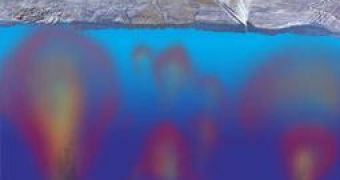Jupiter's natural satellite Europa, may be the only body in the solar system, except Earth, to have a liquid water ocean inside which life could have appeared and evolved. In order to study the remote satellite, scientists have designed a probe similar to a submarine, which will be deployed to Jupiter's moon to prove that beneath the icy crust lies a vast ocean.
The probe, named Endurance, will be subjected to two tests in the Antarctic environment, out of which one will take place in late next year, while the second is scheduled somewhere around 2009. A similar device has already been successfully used to map the balmier waters in the Mexican sinkhole. However, unlike traditional submersibles that only have the capability of moving through bodies of water, the Endurance probe will be equipped with a drill bore that is specially designed to penetrate thick ice crusts. While the lake, 4 kilometers wide and 40 meters deep, in which it will be tested has only a 4 meter thick ice sheet covering it, the crust of ice on Europa could be more than a few kilometers thick.
Once the probe penetrates the solid surface of the lake, it will have the task of creating a three dimensional map and at the same time looking for any visible signs of life in the frigid water that can present a temperature of below fifty degrees Celsius.
The most difficult aspect of the task will be testing the probe's capability of navigating the unknown environment on its own while keeping constant radio contact with its operators. The test involves navigating the cold waters of the lake up to eight hours at a time in order to evaluate its ability of functioning in the alien environment presented by Europa.
At the time it will be sent to Jupiter's moon, the probe will most probably be programmed in order for it to act and take intelligent decisions, as operators on Earth will have no means of controlling the probe, that is, getting real time feedback and inputting commands at the same time, due to two facts: firstly, Europa is too far away to make real time communication with the probe possible and secondly, even if it were closer to Earth, the thick sheet of ice covering it would prevent radio transmissions.
For now, the probe is being pre-programmed for its test in the Antarctic lake and will follow scheduled path. According to scientists who designed it, in order not to disturb the studied environment with its propellers, the probe will instead lower scientific instruments to make measurements regarding temperature and chemical composition.
Originally, scientists believed that Europa will be severely affected by a high amount of radiation hitting it but recent measurements made with the spacecraft Galileo revealed that the radiation level on its surface is actually two-thirds lower than predicted. Furthermore, data received from Galileo show the possibility of existence of high amounts of carbon dioxide and sulphur dioxide, both signs of volcanism probably triggered by tidal waves provoked by Jupiter's immense gravitational pull.
Nevertheless, the probe is currently in the prototype stage of the project. Scientists still have to find a way to penetrate the massive ice crust on Europa and minimize the size of the probe as it is too large to be sent into space.
The future mission will probably include a docking station as well in order to land on the moon's surface and relay radio signal sent by the probe through the thick ice crust.

 14 DAY TRIAL //
14 DAY TRIAL //